Ion Homeostasis, Osmotic Adjustment, and ROS Detoxification Underlie Pea Salinity Tolerance Induced by Pseudomonas putida RT12
Abstract
1. Introduction
2. Materials and Methods
2.1. Preliminary Screening of Acquired Strains for EPS Production
2.2. Quantification of EPS Production Under Salinity
2.3. Assessment of Salt Tolerance, Flocculation, and Sodium Absorption in Halotolerant Strains
2.4. Screening of the Strains for Additional PGP Traits
2.5. Morphological and Molecular Profiling of the Strain
2.6. Soil Processing, Seed Disinfection, and Microbial Inoculation
2.7. Crop Experiments
2.8. P. putida Enhances Morphophysiological Attributes of Pea Under Salinity
2.8.1. Assessing Photosynthetic Pigment Analysis and Relative Water Contents
2.8.2. Nutrient Analysis of Peas Under Salinity and RT12 Inoculation
2.8.3. Analysis of Plant Osmoprotectants
2.8.4. Plant Antioxidants Analysis
2.8.5. Evaluation of Oxidative Burst
2.9. Statistical Analysis
3. Results
3.1. Initial Screening of Strains for Halotolerance and EPS Production
3.2. Bacterial Survival, Flocculation and Sodium Uptake Under Saline Regime
3.3. PGP Potential of Strain RT12
3.4. Molecular Profiling of the Selected Strains
3.5. RT12 Enhances Pea Varieties’ Growth in Saline Conditions
3.6. RT12 Mitigates the Reduction of Pigments and Water in Peas Induced by Salt
3.7. Proline and Antioxidants Elevated in Inoculated Treatments
3.8. Regulation of TSS and TSP Under RT12 Inoculation in Pea
3.9. Modulation of Lipid Peroxidation and ROS Accumulation Under Salinity Stress
3.10. Modulation of Ionic Equilibrium Under Saline Regime in Pea
3.11. Correlation of Morphological Parameters with Biochemical Attributes
4. Discussion
4.1. Halotolerance and PGP Traits of P. putida RT12
4.2. Alleviation of NaCl-Induced Growth Inhibition in Pea Cultivars by RT12 Inoculation
4.3. RT12 Sustains Photosynthetic Performance and Water Retention in Salinity-Stressed Pea
4.4. RT12 Enhances Antioxidants to Alleviate Oxidative Stress
4.5. RT12 Role in TSP and TSS Production in Salt-Stressed Conditions
4.6. RT12 Revive Nutrients Uptake and Protect Pea from Salt-Induced Ionic Imbalance
5. Conclusions
Supplementary Materials
Author Contributions
Funding
Institutional Review Board Statement
Data Availability Statement
Acknowledgments
Conflicts of Interest
References
- Khan, A.A.; Wang, T.; Hussain, T.; Amna; Ali, F.; Shi, F.; Latef, A.A.H.A.; Ali, O.M.; Hayat, K.; Mehmood, S. Halotolerant-Koccuria rhizophila (14asp)-induced amendment of salt stress in pea plants by limiting Na+ uptake and elevating production of antioxidants. Agronomy 2021, 11, 1907. [Google Scholar] [CrossRef]
- Nasir, G.; Zaidi, S.; Tabassum, N.; Asfaq. A review on nutritional composition, health benefits and potential applications of by-products from pea processing. Biomass Convers. Biorefinery 2024, 14, 10829–10842. [Google Scholar] [CrossRef]
- Kuraz Abebe, B. The dietary use of pigeon pea for human and animal diets. Sci. World J. 2022, 2022, 4873008. [Google Scholar] [CrossRef] [PubMed]
- Dave, K.; Kumar, A.; Dave, N.; Jain, M.; Dhanda, P.S.; Yadav, A.; Kaushik, P. Climate change impacts on legume physiology and ecosystem dynamics: A multifaceted perspective. Sustainability 2024, 16, 6026. [Google Scholar] [CrossRef]
- Goyal, R.K.; Mattoo, A.K.; Schmidt, M.A. Rhizobial–host interactions and symbiotic nitrogen fixation in legume crops toward agriculture sustainability. Front. Microbiol. 2021, 12, 669404. [Google Scholar] [CrossRef]
- Liu, W.-X.; Wei, Y.-X.; Li, R.-C.; Chen, Z.; Wang, H.-D.; Virk, A.L.; Lal, R.; Zhao, X.; Zhang, H.-L. Improving soil aggregates stability and soil organic carbon sequestration by no-till and legume-based crop rotations in the North China Plain. Sci. Total Environ. 2022, 847, 157518. [Google Scholar] [CrossRef]
- Kumar, S.; Gopinath, K.; Sheoran, S.; Meena, R.S.; Srinivasarao, C.; Bedwal, S.; Jangir, C.K.; Mrunalini, K.; Jat, R.; Praharaj, C. Pulse-based cropping systems for soil health restoration, resources conservation, and nutritional and environmental security in rainfed agroecosystems. Front. Microbiol. 2023, 13, 1041124. [Google Scholar] [CrossRef]
- Khan, A.A.; Wang, Y.-F.; Akbar, R.; Alhoqail, W.A. Mechanistic insights and future perspectives of drought stress management in staple crops. Front. Plant Sci. 2025, 16, 1547452. [Google Scholar] [CrossRef]
- Khan, A.A.; Alnusaire, T.S.; Akbar, R.; Iqbal, B.; Zeb, A.; Soliman, M.H. Use of Biostimulants to Enhance Temperature Tolerance in Oilseed Crops. In Oilseed Crops Under Abiotic Stress: Mitigation Strategies and Future Perspectives; Springer: Berlin/Heidelberg, Germany, 2025; pp. 123–146. [Google Scholar]
- Mehmood, S.; Khan, A.A.; Shi, F.; Tahir, M.; Sultan, T.; Munis, M.F.H.; Kaushik, P.; Alyemeni, M.N.; Chaudhary, H.J. Alleviation of salt stress in wheat seedlings via multifunctional Bacillus aryabhattai PM34: An in-vitro study. Sustainability 2021, 13, 8030. [Google Scholar] [CrossRef]
- Singh, A.; Agrawal, S.; Rajput, V.D.; Ghazaryan, K.; Yesayan, A.; Minkina, T.; Zhao, Y.; Petropoulos, D.; Kriemadis, A.; Papadakis, M. Nanoparticles in revolutionizing crop production and agriculture to address salinity stress challenges for a sustainable future. Discov. Appl. Sci. 2024, 6, 317. [Google Scholar] [CrossRef]
- Zahra, S.T.; Tariq, M.; Abdullah, M.; Ullah, M.K.; Rafiq, A.R.; Siddique, A.; Shahid, M.S.; Ahmed, T.; Jamil, I. Salt-tolerant plant growth-promoting Bacteria (ST-PGPB): An effective strategy for sustainable food production. Curr. Microbiol. 2024, 81, 304. [Google Scholar] [CrossRef]
- Guo, J.; Zhan, L.; Su, X.; Wang, T. Physiological Responses and Quality Alterations of Pea Sprouts Under Salt Stress: Implications for Salt-Tolerant Mechanism. Horticulturae 2024, 10, 966. [Google Scholar] [CrossRef]
- Farooq, M.; Ahmad, R.; Shahzad, M.; Ahmad, K.; Sajjad, Y.; Hassan, A.; Nazir, A.; Shah, M.M.; Kalsoom, B.; Khan, S.A. Evaluation of morphological and biochemical variations in peas under two widespread abiotic stresses. Acta Physiol. Plant. 2024, 46, 109. [Google Scholar] [CrossRef]
- Khalid, M.F.; Huda, S.; Yong, M.; Li, L.; Li, L.; Chen, Z.-H.; Ahmed, T. Alleviation of drought and salt stress in vegetables: Crop responses and mitigation strategies. Plant Growth Regul. 2023, 99, 177–194. [Google Scholar] [CrossRef]
- Abbas, A.; Mansha, S.; Waheed, H.; Siddiq, Z.; Hayyat, M.U.; Zhang, Y.-J.; Alwutayd, K. NaCl stress, tissue specific Na+ and K+ up-take and their effect on growth and physiology of Helianthus annuus L. and Solanum lycopersicum L. Sci. Hortic. 2024, 326, 112454. [Google Scholar] [CrossRef]
- Liu, M.; Liu, X.; Song, Y.; Hu, Y.; Yang, C.; Li, J.; Jin, S.; Gu, K.; Yang, Z.; Huang, W. Tobacco production under global climate change: Combined effects of heat and drought stress and coping strategies. Front. Plant Sci. 2024, 15, 1489993. [Google Scholar] [CrossRef]
- Fan, Y.; Wang, J.; Yan, M.; Wang, X.; Du, G.; Li, H.; Li, M.; Si, B. Salt addition mitigate mortality risk and prolong survival of Robinia pseudoacacia subjected to drought stress. Agronomy 2024, 14, 439. [Google Scholar] [CrossRef]
- Singh, A.; Rajput, V.D.; Lalotra, S.; Agrawal, S.; Ghazaryan, K.; Singh, J.; Minkina, T.; Rajput, P.; Mandzhieva, S.; Alexiou, A. Zinc oxide nanoparticles influence on plant tolerance to salinity stress: Insights into physiological, biochemical, and molecular responses. Environ. Geochem. Health 2024, 46, 148. [Google Scholar] [CrossRef]
- Khan, A.A.; Wang, Y.-F.; Zeb, A.; Hayat, K.; Alhoqail, W.A.; Soliman, M.H. Beneficial elements and their roles against soil pollution. In Beneficial Elements for Remediation of Heavy Metals in Polluted Soil; Elsevier: Amsterdam, The Netherlands, 2025; pp. 1–32. [Google Scholar]
- Zhao, S.; Tariq, F.; Ma, C. Integrative dynamics of cell wall architecture and plant growth under salt stress. Front. Plant Sci. 2025, 16, 1644412. [Google Scholar] [CrossRef]
- Wang, L.; Tanveer, M.; Wang, H.; Arnao, M.B. Melatonin as a key regulator in seed germination under abiotic stress. J. Pineal Res. 2024, 76, e12937. [Google Scholar] [CrossRef]
- Kamran, M.; Wang, D.; Xie, K.; Lu, Y.; Shi, C.; Sabagh, A.E.; Gu, W.; Xu, P. Pre-sowing seed treatment with kinetin and calcium mitigates salt induced inhibition of seed germination and seedling growth of choysum (Brassica rapa var. parachinensis). Ecotoxicol. Environ. Saf. 2021, 227, 112921. [Google Scholar] [CrossRef]
- Javaid, M.M.; Mahmood, A.; Alshaya, D.S.; AlKahtani, M.D.; Waheed, H.; Wasaya, A.; Khan, S.A.; Naqve, M.; Haider, I.; Shahid, M.A. Influence of environmental factors on seed germination and seedling characteristics of perennial ryegrass (Lolium perenne L.). Sci. Rep. 2022, 12, 9522. [Google Scholar] [CrossRef]
- Al Murad, M.; Muneer, S. Physiological and molecular analysis revealed the role of silicon in modulating salinity stress in mung bean. Agriculture 2023, 13, 1493. [Google Scholar] [CrossRef]
- Alharbi, K.; Al-Osaimi, A.A.; Alghamdi, B.A. Sodium chloride (NaCl)-induced physiological alteration and oxidative stress generation in Pisum sativum (L.): A toxicity assessment. ACS Omega 2022, 7, 20819–20832. [Google Scholar] [CrossRef] [PubMed]
- Khan, A.A.; Wang, T.; Nisa, Z.U.; Alnusairi, G.S.; Shi, F. Insights into cadmium-induced morphophysiological disorders in Althea rosea Cavan and its phytoremediation through the exogeneous citric acid. Agronomy 2022, 12, 2776. [Google Scholar] [CrossRef]
- Haque, M.M.; Biswas, M.S.; Mosharaf, M.K.; Haque, M.A.; Islam, M.S.; Nahar, K.; Islam, M.M.; Shozib, H.B.; Islam, M.M. Halotolerant biofilm-producing rhizobacteria mitigate seawater-induced salt stress and promote growth of tomato. Sci. Rep. 2022, 12, 5599. [Google Scholar] [CrossRef]
- Sharma, S.; Kumawat, K.C. Role of rhizospheric microbiome in enhancing plant attributes and soil health for sustainable agriculture. In Core Microbiome: Improving Crop Quality and Productivity; Wiley: Hoboken, NJ, USA, 2022; pp. 139–162. [Google Scholar]
- Giaouris, E.; Heir, E.; Desvaux, M.; Hébraud, M.; Møretrø, T.; Langsrud, S.; Doulgeraki, A.; Nychas, G.-J.; Kačániová, M.; Czaczyk, K. Intra-and inter-species interactions within biofilms of important foodborne bacterial pathogens. Front. Microbiol. 2015, 6, 841. [Google Scholar] [CrossRef]
- Al-Tayawi, T.S.; Adel, E.M.; Omer, F.H. An overview of biofilm as a virulence factor for bacteria to survive in the harsh environment. Int. J. Med. Sci. Clin. Res. Stud. 2023, 3, 1188–1197. [Google Scholar]
- Dabhi, M.; Anavadiya, B.; Prajapati, K.; Sharma, S. Biofilms: The Unsung Heroes of Soil Health and Crop Productivity. In Climate Change and Soil Microorganisms for Environmental Sustainability; Springer: Berlin/Heidelberg, Germany, 2025; pp. 321–346. [Google Scholar]
- Khan, A.A.; Yongfeng, W.; Soliman, M.H.; Alhoqail, W.A.; ALHaithloul, H.S.; Alghanem, S.M.; Latef, A.A.H.A. PGPR in Agriculture: A Sustainable Approach to Increasing Climate Change Resilience. In Plant-Microbe Interactions for Environmental and Agricultural Sustainability; Springer: Berlin/Heidelberg, Germany, 2025; pp. 129–154. [Google Scholar]
- Ansari, F.A.; Ahmad, I.; Pichtel, J.; Husain, F.M. Pantoea agglomerans FAP10: A novel biofilm-producing PGPR strain improves wheat growth and soil resilience under salinity stress. Environ. Exp. Bot. 2024, 222, 105759. [Google Scholar] [CrossRef]
- Thakur, R.; Yadav, S. Biofilm forming, exopolysaccharide producing and halotolerant, bacterial consortium mitigates salinity stress in Triticum aestivum. Int. J. Biol. Macromol. 2024, 262, 130049. [Google Scholar] [CrossRef]
- Luqman, M.; Ahmad, M.; Dar, A.; Hussain, A.; Zulfiqar, U.; Mumtaz, M.Z.; Mustafa, A.; Mustafa, A.E.-Z.M.; Elshikh, M.S. PGPR and nutrient consortia promoted cotton growth, antioxidant enzymes, and mineral uptake by suppressing sooty mold in arid climate. Front. Microbiol. 2025, 16, 1551465. [Google Scholar] [CrossRef]
- Malik, L.; Hussain, S.; Shahid, M.; Mahmood, F.; Ali, H.M.; Malik, M.; Sanaullah, M.; Zahid, Z.; Shahzad, T. Co-applied biochar and drought tolerant PGPRs induced more improvement in soil quality and wheat production than their individual applications under drought conditions. PeerJ 2024, 12, e18171. [Google Scholar] [CrossRef] [PubMed]
- Ansari, F.; Jabeen, M.; Ahmad, I. Pseudomonas azotoformans FAP5, a novel biofilm-forming PGPR strain, alleviates drought stress in wheat plant. Int. J. Environ. Sci. Technol. 2021, 18, 3855–3870. [Google Scholar] [CrossRef]
- Ansari, F.A.; Ahmad, I. Isolation, functional characterization and efficacy of biofilm-forming rhizobacteria under abiotic stress conditions. Antonie Leeuwenhoek 2019, 112, 1827–1839. [Google Scholar] [CrossRef] [PubMed]
- Bright, J.P.; Maheshwari, H.S.; Thangappan, S.; Perveen, K.; Bukhari, N.A.; Mitra, D.; Sayyed, R.; Mastinu, A. Biofilmed-PGPR: Next-generation bioinoculant for plant growth promotion in rice under changing climate. Rice Sci. 2025, 32, 94–106. [Google Scholar] [CrossRef]
- Gupta, G.; Snehi, S.K.; Singh, V. Role of PGPR in biofilm formations and its importance in plant health. In Biofilms Plant Soil Health; Wiley: Hoboken, NJ, USA, 2017; pp. 27–42. [Google Scholar]
- Fatima, T.; Mishra, I.; Verma, R.; Arora, N.K. Mechanisms of halotolerant plant growth promoting Alcaligenes sp. involved in salt tolerance and enhancement of the growth of rice under salinity stress. 3 Biotech 2020, 10, 361. [Google Scholar] [CrossRef]
- Rojas-Tapias, D.; Moreno-Galván, A.; Pardo-Díaz, S.; Obando, M.; Rivera, D.; Bonilla, R. Effect of inoculation with plant growth-promoting bacteria (PGPB) on amelioration of saline stress in maize (Zea mays). Appl. Soil Ecol. 2012, 61, 264–272. [Google Scholar] [CrossRef]
- Ashraf, M.; Hasnain, S.; Berge, O.; Mahmood, T. Inoculating wheat seedlings with exopolysaccharide-producing bacteria restricts sodium uptake and stimulates plant growth under salt stress. Biol. Fertil. Soils 2004, 40, 157–162. [Google Scholar] [CrossRef]
- Alhoqail, W.A. Exopolysaccharide-Producing PGPR: Mechanisms for Alleviating Salinity-Induced Plant Stress. Pol. J. Environ. Stud. 2025. [Google Scholar] [CrossRef]
- Alhoqail, W.A. ACC-deaminase producing Pseudomonas putida RT12 inoculation: A promising strategy for improving Brassica juncea tolerance to salinity stress. Not. Bot. Horti Agrobot. Cluj-Napoca 2024, 52, 13550. [Google Scholar] [CrossRef]
- Akbar, A.; Han, B.; Khan, A.H.; Feng, C.; Ullah, A.; Khan, A.S.; He, L.; Yang, X. A transcriptomic study reveals salt stress alleviation in cotton plants upon salt tolerant PGPR inoculation. Environ. Exp. Bot. 2022, 200, 104928. [Google Scholar] [CrossRef]
- Chakraborty, S.; Mondal, S. Halotolerant Citrobacter sp. remediates salinity stress and promotes the growth of Vigna radiata (L) by secreting extracellular polymeric substances (EPS) and biofilm formation: A novel active cell for microbial desalination cell (MDC). Int. Microbiol. 2024, 27, 291–301. [Google Scholar] [CrossRef]
- Afridi, M.S.; Mahmood, T.; Salam, A.; Mukhtar, T.; Mehmood, S.; Ali, J.; Khatoon, Z.; Bibi, M.; Javed, M.T.; Sultan, T. Induction of tolerance to salinity in wheat genotypes by plant growth promoting endophytes: Involvement of ACC deaminase and antioxidant enzymes. Plant Physiol. Biochem. 2019, 139, 569–577. [Google Scholar] [CrossRef]
- Molina, R.; López, G.; Coniglio, A.; Furlan, A.; Mora, V.; Rosas, S.; Cassán, F. Day and blue light modify growth, cell physiology and indole-3-acetic acid production of Azospirillum brasilense Az39 under planktonic growth conditions. J. Appl. Microbiol. 2021, 130, 1671–1683. [Google Scholar] [CrossRef] [PubMed]
- Khan, M.A.; Hamayun, M.; Asaf, S.; Khan, M.; Yun, B.-W.; Kang, S.-M.; Lee, I.-J. Rhizospheric Bacillus spp. rescues plant growth under salinity stress via regulating gene expression, endogenous hormones, and antioxidant system of Oryza sativa L. Front. Plant Sci. 2021, 12, 665590. [Google Scholar] [CrossRef] [PubMed]
- Loper, J.; Schroth, M. Influence of bacterial sources of indole-3-acetic acid on root elongation of sugar beet. Phytopathology 1986, 76, 386–389. [Google Scholar] [CrossRef]
- Zafar-Ul-Hye, M.; Yaseen, R.; Abid, M.; Abbas, M.; Ahmad, M.; Rahi, A.A.; Danish, S. Rhizobacteria having ACC-deaminase and biogas slurry can mitigate salinity adverse effects in wheat. Pak. J. Bot. 2022, 54, 297–303. [Google Scholar] [CrossRef]
- Jalili, F.; Khavazi, K.; Pazira, E.; Nejati, A.; Rahmani, H.A.; Sadaghiani, H.R.; Miransari, M. Isolation and characterization of ACC deaminase-producing fluorescent pseudomonads, to alleviate salinity stress on canola (Brassica napus L.) growth. J. Plant Physiol. 2009, 166, 667–674. [Google Scholar] [CrossRef]
- Kumar, A.; Maurya, B.; Raghuwanshi, R. Isolation and characterization of PGPR and their effect on growth, yield and nutrient content in wheat (Triticum aestivum L.). Biocatal. Agric. Biotechnol. 2014, 3, 121–128. [Google Scholar] [CrossRef]
- Aydi Ben Abdallah, R.; Jabnoun-Khiareddine, H.; Regaieg, H.; Daami-Remadi, M. Effect of indigenous bio-inoculants and commercial biological inputs on soil microbial population, soil health dynamics and pepper (Capsicum annum L.) production. Arch. Agron. Soil Sci. 2023, 69, 3484–3501. [Google Scholar] [CrossRef]
- Moustaine, M.; Elkahkahi, R.; Benbouazza, A.; Benkirane, R.; Achbani, E. Effect of plant growth promoting rhizobacterial (PGPR) inoculation on growth in tomato (Solanum lycopersicum L.) and characterization for direct PGP abilities in Morocco. Int. J. Environ. Agric. Biotechnol. 2017, 2, 238708. [Google Scholar] [CrossRef]
- Li, H.; Qiu, Y.; Yao, T.; Ma, Y.; Zhang, H.; Yang, X. Effects of PGPR microbial inoculants on the growth and soil properties of Avena sativa, Medicago sativa, and Cucumis sativus seedlings. Soil Tillage Res. 2020, 199, 104577. [Google Scholar] [CrossRef]
- Ahmed, W.; Staley, C.; Sidhu, J.; Sadowsky, M.; Toze, S. Amplicon-based profiling of bacteria in raw and secondary treated wastewater from treatment plants across Australia. Appl. Microbiol. Biotechnol. 2017, 101, 1253–1266. [Google Scholar] [CrossRef] [PubMed]
- Nelson, D.A.; Sommers, L.E. Total carbon, organic carbon, and organic matter. Methods Soil Anal. Part 2 Chem. Microbiol. Prop. 1983, 9, 539–579. [Google Scholar]
- McLean, E.; Hartwig, R.; Eckert, D.; Triplett, G. Basic cation saturation ratios as a basis for fertilizing and liming agronomic crops. II. field studies 1. Agron. J. 1983, 75, 635–639. [Google Scholar] [CrossRef]
- Etesami, H.; Maheshwari, D.K. Use of plant growth promoting rhizobacteria (PGPRs) with multiple plant growth promoting traits in stress agriculture: Action mechanisms and future prospects. Ecotoxicol. Environ. Saf. 2018, 156, 225–246. [Google Scholar] [CrossRef]
- Kumari, R.; Ashraf, S.; Bagri, G.; Khatik, S.; Bagri, D.; Bagdi, D. Extraction and estimation of chlorophyll content of seed treated lentil crop using DMSO and acetone. J. Pharmacogn. Phytochem. 2018, 7, 249–250. [Google Scholar]
- El Nahhas, N.; AlKahtani, M.D.; Abdelaal, K.A.; Al Husnain, L.; AlGwaiz, H.I.; Hafez, Y.M.; Attia, K.A.; El-Esawi, M.A.; Ibrahim, M.F.; Elkelish, A. Biochar and jasmonic acid application attenuates antioxidative systems and improves growth, physiology, nutrient uptake and productivity of faba bean (Vicia faba L.) irrigated with saline water. Plant Physiol. Biochem. 2021, 166, 807–817. [Google Scholar] [CrossRef]
- Bates, L.S.; Waldren, R.P.; Teare, I. Rapid determination of free proline for water-stress studies. Plant Soil 1973, 39, 205–207. [Google Scholar] [CrossRef]
- Li, C.; Zhang, M.; Qi, N.; Liu, H.; Zhao, Z.; Huang, P.; Liao, W. Abscisic acid induces adventitious rooting in cucumber (Cucumis sativus L.) by enhancing sugar synthesis. Plants 2022, 11, 2354. [Google Scholar] [CrossRef]
- Mendez, R.L.; Kwon, J.Y. Effect of extraction condition on protein recovery and phenolic interference in Pacific dulse (Devaleraea mollis). J. Appl. Phycol. 2021, 33, 2497–2509. [Google Scholar] [CrossRef]
- Beauchamp, C.; Fridovich, I. Superoxide dismutase: Improved assays and an assay applicable to acrylamide gels. Anal. Biochem. 1971, 44, 276–287. [Google Scholar] [CrossRef]
- Luck, H. Methods in Enzymatic Analysis II; Bergmeyer, H.U., Ed.; Academic Press: Cambridge, MA, USA, 1974. [Google Scholar]
- Reddy, K.; Subhani, S.; Khan, P.; Kumar, K. Effect of light and benzyladenine on dark-treated growing rice (Oryza sativa) leaves II. Changes in peroxidase activity. Plant Cell Physiol. 1985, 26, 987–994. [Google Scholar] [CrossRef]
- Li, X.; Sun, P.; Zhang, Y.; Jin, C.; Guan, C. A novel PGPR strain Kocuria rhizophila Y1 enhances salt stress tolerance in maize by regulating phytohormone levels, nutrient acquisition, redox potential, ion homeostasis, photosynthetic capacity and stress-responsive genes expression. Environ. Exp. Bot. 2020, 174, 104023. [Google Scholar] [CrossRef]
- Gamalero, E.; Lingua, G.; Glick, B.R. Ethylene, ACC, and the plant growth-promoting enzyme ACC deaminase. Biology 2023, 12, 1043. [Google Scholar] [CrossRef] [PubMed]
- Azeem, M.A.; Shah, F.H.; Ullah, A.; Ali, K.; Jones, D.A.; Khan, M.E.H.; Ashraf, A. Biochemical characterization of halotolerant Bacillus safensis PM22 and its potential to enhance growth of maize under salinity stress. Plants 2022, 11, 1721. [Google Scholar] [CrossRef]
- Cackett, L.; Cannistraci, C.V.; Meier, S.; Ferrandi, P.; Pěnčík, A.; Gehring, C.; Novák, O.; Ingle, R.A.; Donaldson, L. Salt-specific gene expression reveals elevated auxin levels in Arabidopsis thaliana plants grown under saline conditions. Front. Plant Sci. 2022, 13, 804716. [Google Scholar] [CrossRef]
- Ali, N.; Abbas, S.A.A.A.; Sharif, L.; Shafiq, M.; Kamran, Z.; Haseeb, M.; Shahid, M.A. Microbial extracellular polymeric substance and impacts on soil aggregation. In Bacterial Secondary Metabolites; Elsevier: Amsterdam, The Netherlands, 2024; pp. 221–237. [Google Scholar]
- Karmakar, K.; Roy, D.; Pal, S.; Chowdhury, B.; Choudhury, A. EPS-Producing Bacteria Promote Aggregation in Soil Preventing the Leaching Loss of Nutrient: EPS-Producing Bacteria Promote Aggregation in Soil Preventing the Leaching Loss of Nutrient. Curr. Microbiol. 2025, 82, 307. [Google Scholar] [CrossRef]
- Oliva, G.; Di Stasio, L.; Vigliotta, G.; Guarino, F.; Cicatelli, A.; Castiglione, S. Exploring the potential of four novel halotolerant bacterial strains as plant-growth-promoting rhizobacteria (PGPR) under saline conditions. Appl. Sci. 2023, 13, 4320. [Google Scholar] [CrossRef]
- Kerbab, S.; Silini, A.; Chenari Bouket, A.; Cherif-Silini, H.; Eshelli, M.; El Houda Rabhi, N.; Belbahri, L. Mitigation of NaCl stress in wheat by rhizosphere engineering using salt habitat adapted PGPR halotolerant bacteria. Appl. Sci. 2021, 11, 1034. [Google Scholar] [CrossRef]
- Patel, M.; Vurukonda, S.; Patel, A. Multi-trait halotolerant plant growth-promoting bacteria mitigate induced salt stress and enhance growth of Amaranthus viridis. J. Soil Sci. Plant Nutr. 2023, 23, 1860–1883. [Google Scholar]
- Xie, X.; Gan, L.; Wang, C.; He, T. Salt-tolerant plant growth-promoting bacteria as a versatile tool for combating salt stress in crop plants. Arch. Microbiol. 2024, 206, 341. [Google Scholar]
- Li, H.-P.; Ma, H.-B.; Zhang, J.-L. Halo-tolerant plant growth-promoting bacteria-mediated plant salt resistance and microbiome-based solutions for sustainable agriculture in saline soils. FEMS Microbiol. Ecol. 2025, 101, fiaf037. [Google Scholar] [CrossRef] [PubMed]
- Ullah, H.; Jan, T. Germination test, seedling growth, and physiochemical traits are used to screen okra varieties for salt tolerance. Heliyon 2024, 10, e34152. [Google Scholar] [CrossRef]
- Nazim, M.; Fatima, M.; Hussain, A.; Ali, M.; Mathpal, B.; Alwahibi, M.S. Salt stress effects on growth, physiology, and ionic concentrations in hydroponically grown barley genotypes. J. King Saud Univ. Sci. 2024, 36, 103448. [Google Scholar]
- Din, B.U.; Sarfraz, S.; Xia, Y.; Kamran, M.A.; Javed, M.T.; Sultan, T.; Munis, M.F.H.; Chaudhary, H.J. Mechanistic elucidation of germination potential and growth of wheat inoculated with exopolysaccharide and ACC-deaminase producing Bacillus strains under induced salinity stress. Ecotoxicol. Environ. Saf. 2019, 183, 109466. [Google Scholar]
- Farahat, M.G.; Mahmoud, M.K.; Youseif, S.H.; Saleh, S.A.; Kamel, Z. Alleviation of salinity stress in wheat by ACC deaminase-producing Bacillus aryabhattai EWR29 with multifarious plant growth-promoting attributes. Plant Arch. 2020, 20, 417–429. [Google Scholar]
- Nadeem, S.M.; Ahmad, M.; Tufail, M.A.; Asghar, H.N.; Nazli, F.; Zahir, Z.A. Appraising the potential of EPS-producing rhizobacteria with ACC-deaminase activity to improve growth and physiology of maize under drought stress. Physiol. Plant. 2021, 172, 463–476. [Google Scholar]
- Hameed, A.; Ahmed, M.Z.; Hussain, T.; Aziz, I.; Ahmad, N.; Gul, B.; Nielsen, B.L. Effects of salinity stress on chloroplast structure and function. Cells 2021, 10, 2023. [Google Scholar] [CrossRef]
- Stefanov, M.A.; Rashkov, G.D.; Yotsova, E.K.; Dobrikova, A.G.; Apostolova, E.L. Impact of salinity on the energy transfer between pigment–protein complexes in photosynthetic apparatus, functions of the oxygen-evolving complex and photochemical activities of photosystem II and photosystem I in two Paulownia lines. Int. J. Mol. Sci. 2023, 24, 3108. [Google Scholar]
- Al-Shammari, W.B.; Altamimi, H.R.; Abdelaal, K. Improvement in physiobiochemical and yield characteristics of pea plants with nano silica and melatonin under salinity stress conditions. Horticulturae 2023, 9, 711. [Google Scholar] [CrossRef]
- Naz, S.; Bilal, A.; Saddiq, B.; Ejaz, S.; Ali, S.; Ain Haider, S.T.; Sardar, H.; Nasir, B.; Ahmad, I.; Tiwari, R.K. Foliar application of salicylic acid improved growth, yield, quality and photosynthesis of pea (Pisum sativum L.) by improving antioxidant defense mechanism under saline conditions. Sustainability 2022, 14, 14180. [Google Scholar] [CrossRef]
- Cha, S.-J.; Park, H.J.; Kwon, S.-J.; Lee, J.-K.; Park, J.H. Early detection of plant stress using the internal electrical conductivity of Capsicum annuum in response to temperature and salinity stress. Plant Growth Regul. 2021, 95, 371–380. [Google Scholar] [CrossRef]
- Gupta, A.; Tiwari, R.K.; Shukla, R.; Singh, A.N.; Sahu, P.K. Salinity alleviator bacteria in rice (Oryza sativa L.), their colonization efficacy, and synergism with melatonin. Front. Plant Sci. 2023, 13, 1060287. [Google Scholar] [CrossRef]
- Khan, M.A.; Sahile, A.A.; Jan, R.; Asaf, S.; Hamayun, M.; Imran, M.; Adhikari, A.; Kang, S.-M.; Kim, K.-M.; Lee, I.-J. Halotolerant bacteria mitigate the effects of salinity stress on soybean growth by regulating secondary metabolites and molecular responses. BMC Plant Biol. 2021, 21, 176. [Google Scholar] [CrossRef]
- Maxton, A.; Singh, P.; Masih, S.A. ACC deaminase-producing bacteria mediated drought and salt tolerance in Capsicum annuum. J. Plant Nutr. 2018, 41, 574–583. [Google Scholar] [CrossRef]
- Zulfiqar, F.; Ashraf, M. Proline alleviates abiotic stress induced oxidative stress in plants. J. Plant Growth Regul. 2023, 42, 4629–4651. [Google Scholar] [CrossRef]
- Neshat, M.; Abbasi, A.; Hosseinzadeh, A.; Sarikhani, M.R.; Dadashi Chavan, D.; Rasoulnia, A. Plant growth promoting bacteria (PGPR) induce antioxidant tolerance against salinity stress through biochemical and physiological mechanisms. Physiol. Mol. Biol. Plants 2022, 28, 347–361. [Google Scholar] [CrossRef]
- Sapre, S.; Gontia-Mishra, I.; Tiwari, S. Plant growth-promoting rhizobacteria ameliorates salinity stress in pea (Pisum sativum). J. Plant Growth Regul. 2022, 41, 647–656. [Google Scholar] [CrossRef]
- Elbagory, M.; Altihani, F.A.; El-Nahrawy, S.; Shalaby, M.; Omara, A.E.-D.; Singh, J.; Andabaka, Ž.; Širić, I. Feasibility of Nano-Urea and PGPR on Salt Stress Amelioration in Reshmi Amaranth (Amaranthus tricolor): Stress Markers and Enzymatic Response. Horticulturae 2025, 11, 280. [Google Scholar] [CrossRef]
- Shahid, M.; Altaf, M.; Danish, M. The halotolerant exopolysaccharide-producing Rhizobium azibense increases the salt tolerance mechanism in Phaseolus vulgaris (L.) by improving growth, ion homeostasis, and antioxidant defensive enzymes. Chemosphere 2024, 360, 142431. [Google Scholar] [CrossRef] [PubMed]
- Costa-Gutierrez, S.B.; Lami, M.J.; Santo, M.C.C.-D.; Zenoff, A.M.; Vincent, P.A.; Molina-Henares, M.A.; Espinosa-Urgel, M.; de Cristóbal, R.E. Plant growth promotion by Pseudomonas putida KT2440 under saline stress: Role of eptA. Appl. Microbiol. Biotechnol. 2020, 104, 4577–4592. [Google Scholar] [CrossRef] [PubMed]
- El-Aal, M.S.A.; Farag, H.R.; Elbar, O.H.A.; Zayed, M.S.; Khalifa, G.S.; Abdellatif, Y.M. Synergistic effect of Pseudomonas putida and endomycorrhizal inoculation on the physiological response of onion (Allium cepa L.) to saline conditions. Sci. Rep. 2024, 14, 21373. [Google Scholar] [CrossRef]
- Ahmad, E.; Khan, M.S.; Zaidi, A. ACC deaminase producing Pseudomonas putida strain PSE3 and Rhizobium leguminosarum strain RP2 in synergism improves growth, nodulation and yield of pea grown in alluvial soils. Symbiosis 2013, 61, 93–104. [Google Scholar] [CrossRef]
- Hassan, A.H.; Alkhalifah, D.H.M.; Al Yousef, S.A.; Beemster, G.T.; Mousa, A.S.; Hozzein, W.N.; AbdElgawad, H. Salinity stress enhances the antioxidant capacity of Bacillus and Planococcus species isolated from saline lake environment. Front. Microbiol. 2020, 11, 561816. [Google Scholar] [CrossRef]
- Liu, X.; Chai, J.; Zhang, Y.; Zhang, C.; Lei, Y.; Li, Q.; Yao, T. Halotolerant rhizobacteria mitigate the effects of salinity stress on maize growth by secreting exopolysaccharides. Environ. Exp. Bot. 2022, 204, 105098. [Google Scholar] [CrossRef]
- Gupta, A.; Rai, S.; Bano, A.; Sharma, S.; Kumar, M.; Binsuwaidan, R.; Suhail Khan, M.; Upadhyay, T.K.; Alshammari, N.; Saeed, M. ACC deaminase produced by PGPR mitigates the adverse effect of osmotic and salinity stresses in Pisum sativum through modulating the antioxidants activities. Plants 2022, 11, 3419. [Google Scholar] [CrossRef]
- Singh, P.; Choudhary, K.K.; Chaudhary, N.; Gupta, S.; Sahu, M.; Tejaswini, B.; Sarkar, S. Salt stress resilience in plants mediated through osmolyte accumulation and its crosstalk mechanism with phytohormones. Front. Plant Sci. 2022, 13, 1006617. [Google Scholar] [CrossRef]
- Ibrahim, H.M.; El-Sawah, A.M. The mode of integration between azotobacter and rhizobium affect plant growth, yield, and physiological responses of pea (Pisum sativum L.). J. Soil Sci. Plant Nutr. 2022, 22, 1238–1251. [Google Scholar] [CrossRef]
- Mehrabi, S.S.; Sabokdast, M.; Bihamta, M.R.; Dedičová, B. The coupling effects of PGPR inoculation and foliar spraying of strigolactone in mitigating the negative effect of salt stress in wheat plants: Insights from phytochemical, growth, and yield attributes. Agriculture 2024, 14, 732. [Google Scholar] [CrossRef]
- Çığ, F.; Sönmez, F.; Nadeem, M.A.; Sabagh, A.E. Effect of biochar and PGPR on the growth and nutrients content of einkorn wheat (Triticum monococcum L.) and post-harvest soil properties. Agronomy 2021, 11, 2418. [Google Scholar] [CrossRef]
- Ahmed, S.; Heo, T.-Y.; Roy Choudhury, A.; Walitang, D.I.; Choi, J.; Sa, T. Accumulation of compatible solutes in rice (Oryza sativa L.) cultivars by inoculation of endophytic plant growth promoting bacteria to alleviate salt stress. Appl. Biol. Chem. 2021, 64, 68. [Google Scholar] [CrossRef]
- Munns, R.; Tester, M. Mechanisms of salinity tolerance. Annu. Rev. Plant Biol. 2008, 59, 651–681. [Google Scholar] [CrossRef] [PubMed]
- Khan, A.; Bibi, S.; Javed, T.; Mahmood, A.; Mehmood, S.; Javaid, M.M.; Ali, B.; Yasin, M.; Abidin, Z.U.; Al-Sadoon, M.K. Effect of salinity stress and surfactant treatment with zinc and boron on morpho-physiological and biochemical indices of fenugreek (Trigonella foenum-graecum). BMC Plant Biol. 2024, 24, 138. [Google Scholar] [CrossRef] [PubMed]
- Naing, A.H.; Maung, T.T.; Kim, C.K. The ACC deaminase-producing plant growth-promoting bacteria: Influences of bacterial strains and ACC deaminase activities in plant tolerance to abiotic stress. Physiol. Plant. 2021, 173, 1992–2012. [Google Scholar] [CrossRef]
- Bharti, C.; Fatima, T.; Mishra, P.; Verma, P.; Bhattacharya, A.; Alaylar, B.; Arora, N.K. Salt-tolerant endophytic Bacillus altitudinis NKA32 with ACC deaminase activity modulates physiochemical mechanisms in rice for adaptation in saline ecosystem. Environ. Sustain. 2024, 7, 231–249. [Google Scholar] [CrossRef]
- Baset, M.M.; Shamsuddin, Z.; Wahab, Z.; Marziah, M. Effect of plant growth promoting rhizobacterial (PGPR) inoculation on growth and nitrogen incorporation of tissue-cultured‘musa’plantlets under nitrogen-free hydroponics condition. Aust. J. Crop Sci. 2010, 4, 85–90. [Google Scholar]
- Dodd, I.C.; Pérez-Alfocea, F. Microbial amelioration of crop salinity stress. J. Exp. Bot. 2012, 63, 3415–3428. [Google Scholar] [CrossRef]
- Wu, Q.-S.; Zou, Y.-N.; He, X.-H. Contributions of arbuscular mycorrhizal fungi to growth, photosynthesis, root morphology and ionic balance of citrus seedlings under salt stress. Acta Physiol. Plant. 2010, 32, 297–304. [Google Scholar]
- Miao, Y.; Luo, X.; Gao, X.; Wang, W.; Li, B.; Hou, L. Exogenous salicylic acid alleviates salt stress by improving leaf photosynthesis and root system architecture in cucumber seedlings. Sci. Hortic. 2020, 272, 109577. [Google Scholar] [CrossRef]
- Ahmad, P.; Ashraf, M.; Hakeem, K.R.; Azooz, M.; Rasool, S.; Chandna, R.; Akram, N.A. Potassium starvation-induced oxidative stress and antioxidant defense responses in Brassica juncea. J. Plant Interact. 2014, 9, 1–9. [Google Scholar] [CrossRef]
- Cordero, I.; Balaguer, L.; Rincón, A.; Pueyo, J.J. Inoculation of tomato plants with selected PGPR represents a feasible alternative to chemical fertilization under salt stress. J. Plant Nutr. Soil Sci. 2018, 181, 694–703. [Google Scholar] [CrossRef]
- Li, R.; Jiao, H.; Sun, B.; Song, M.; Yan, G.; Bai, Z.; Wang, J.; Zhuang, X.; Hu, Q. Understanding Salinity-Driven Modulation of Microbial Interactions: Rhizosphere versus Edaphic Microbiome Dynamics. Microorganisms 2024, 12, 683. [Google Scholar] [CrossRef]
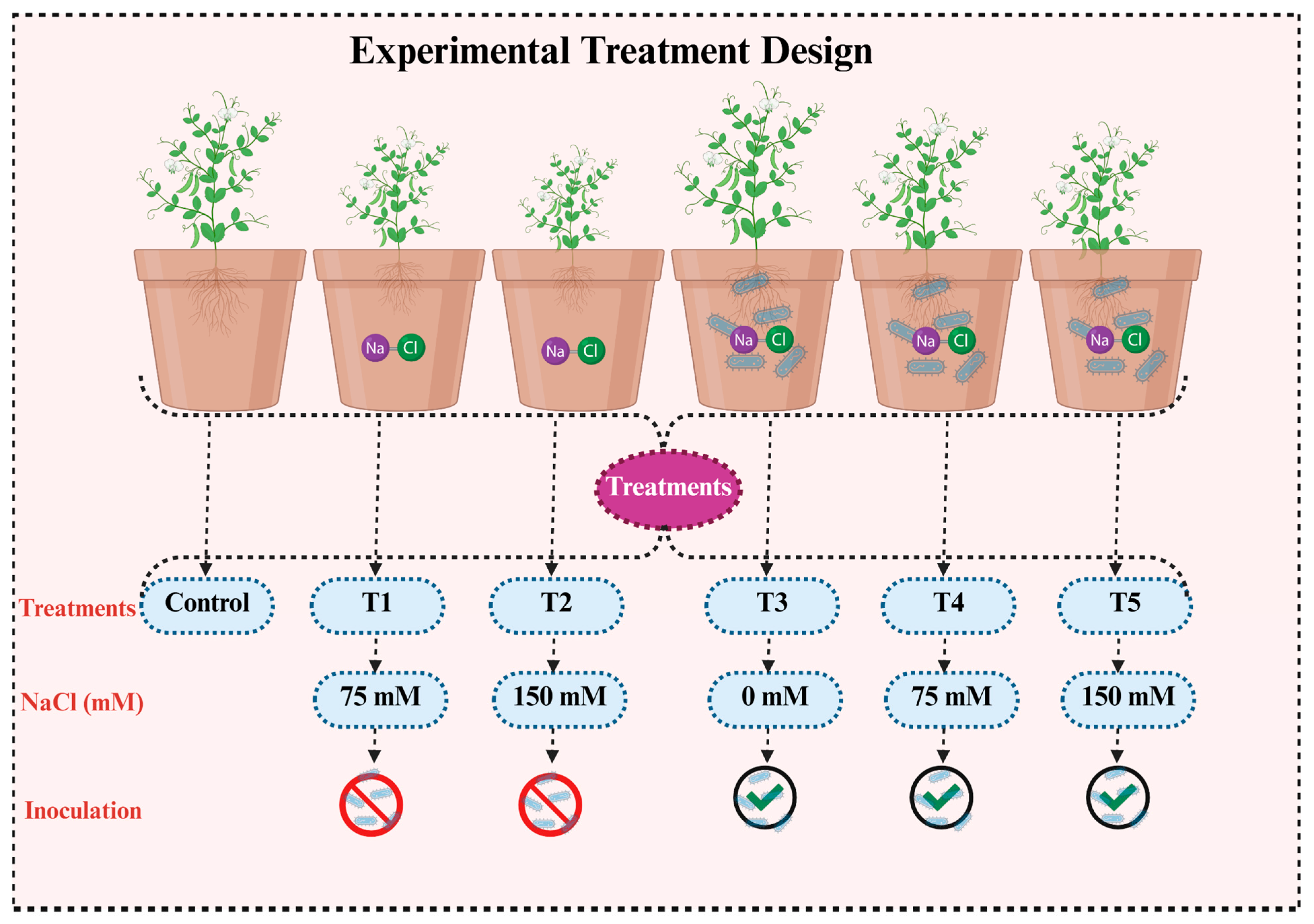
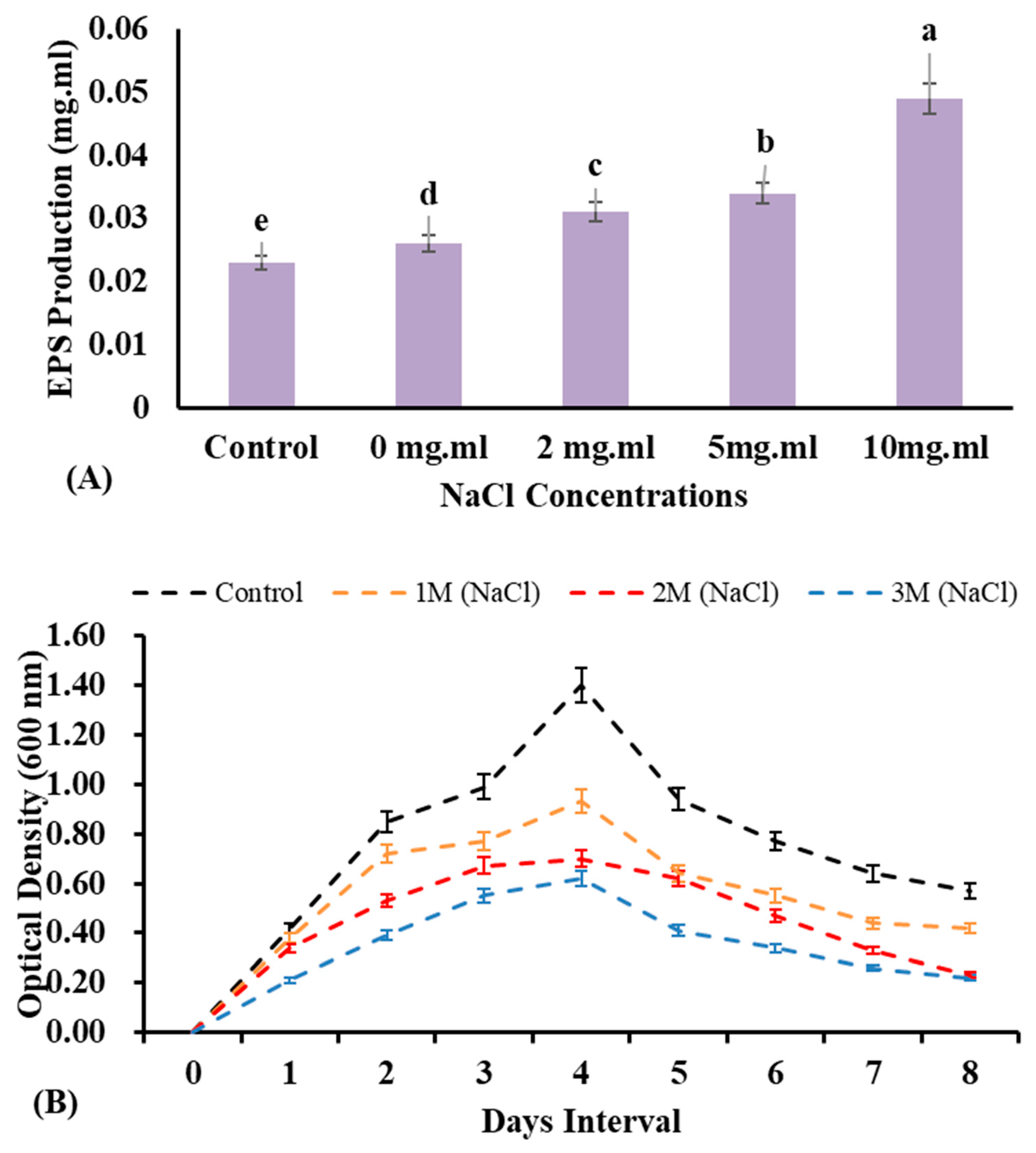
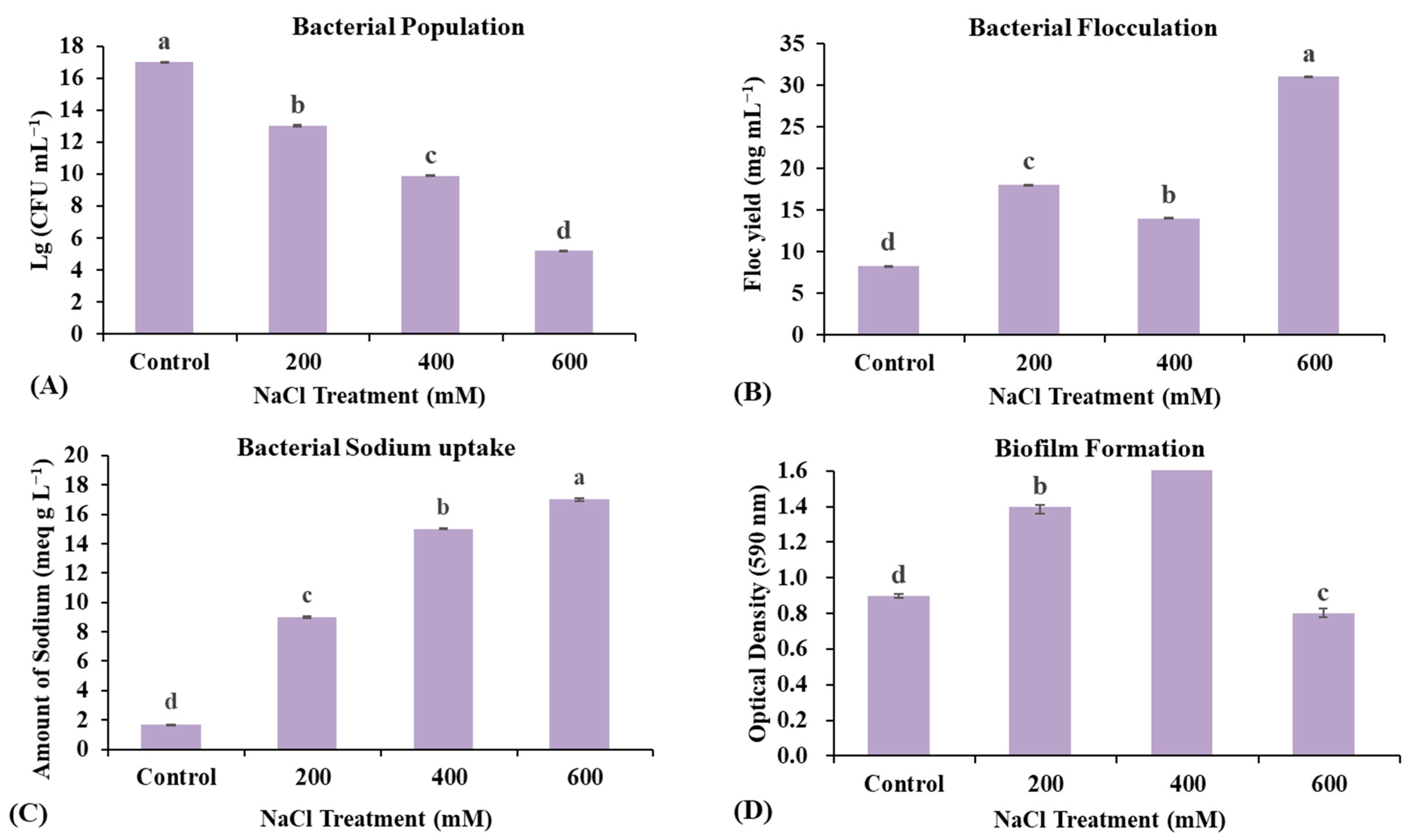
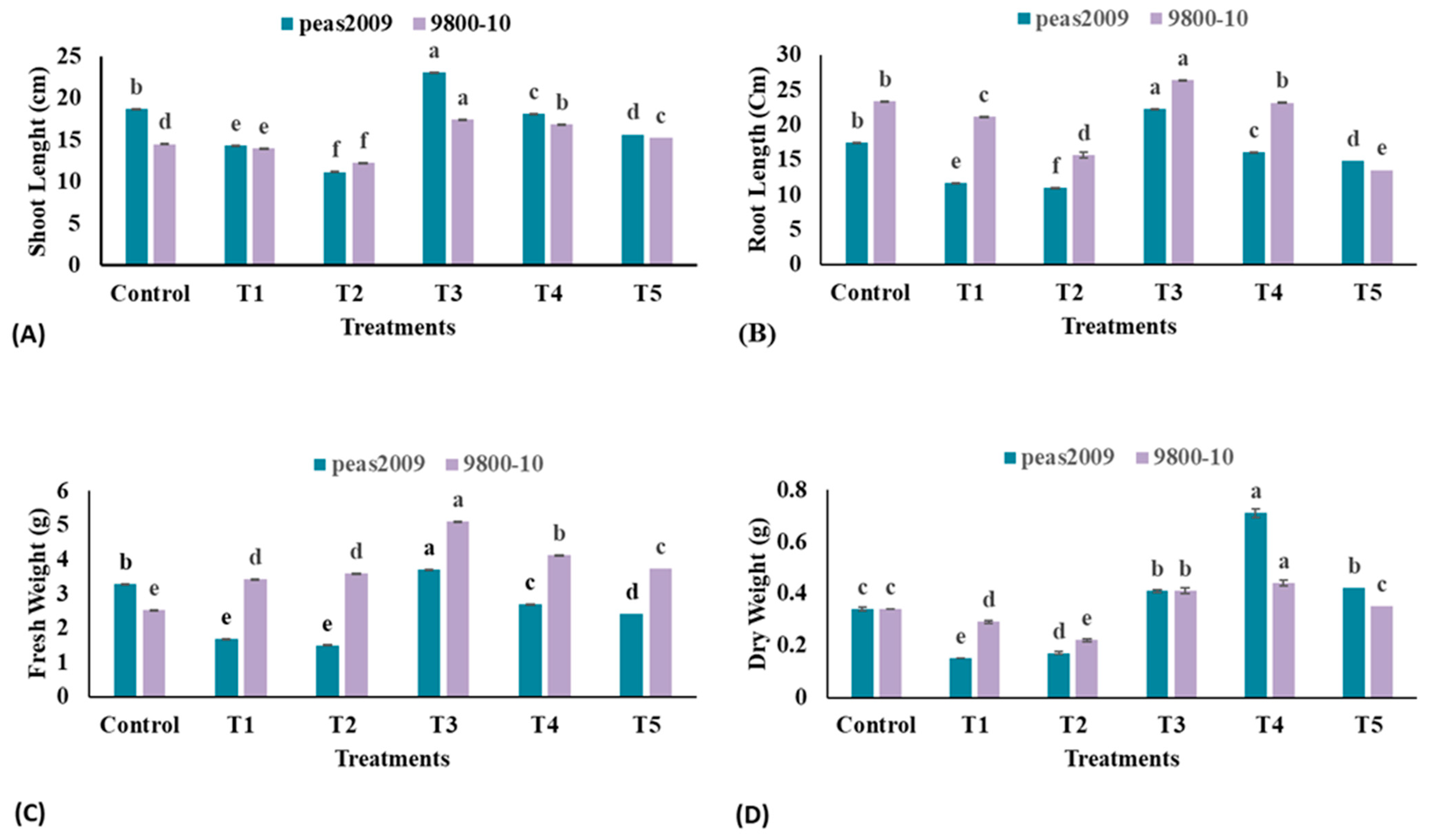
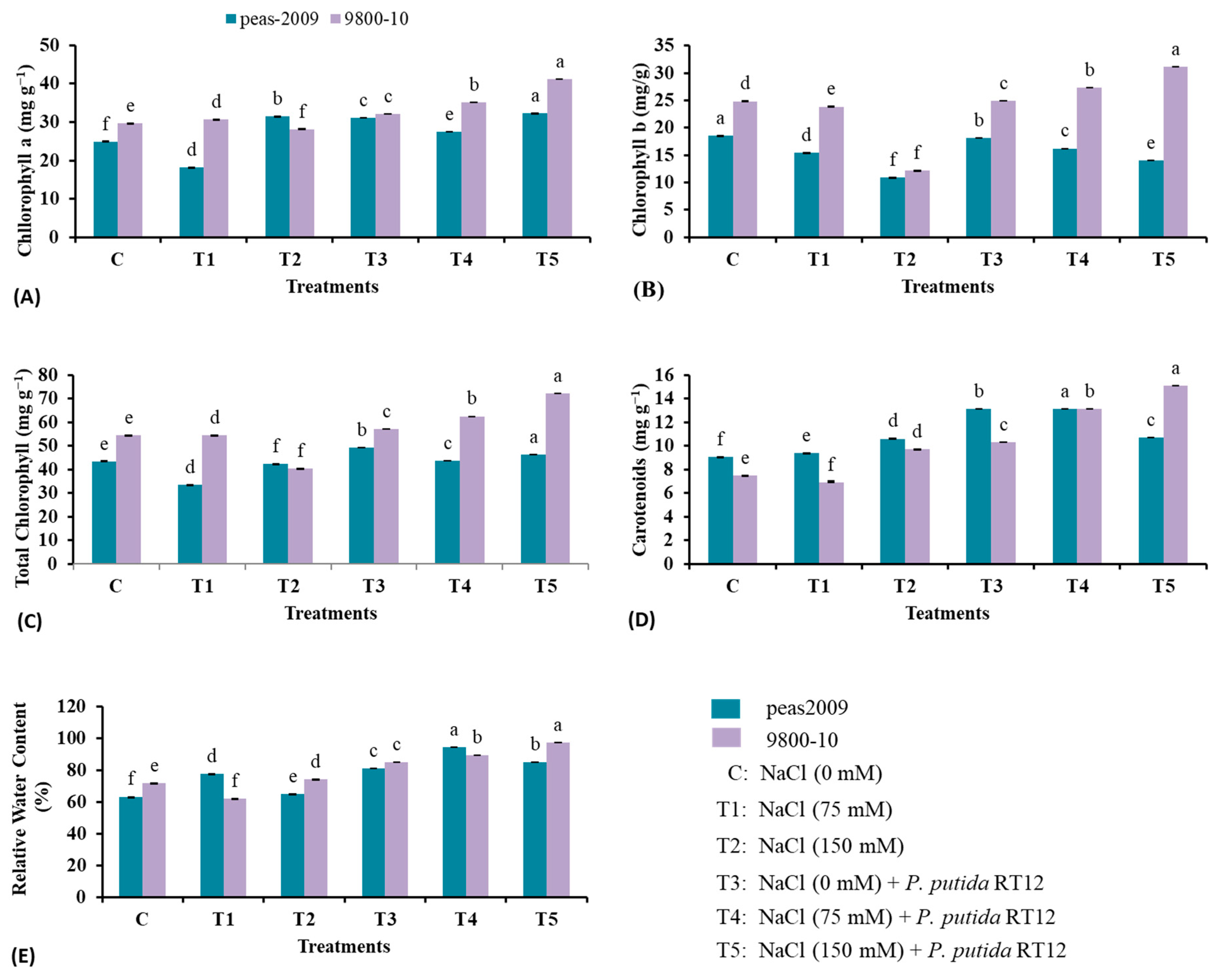
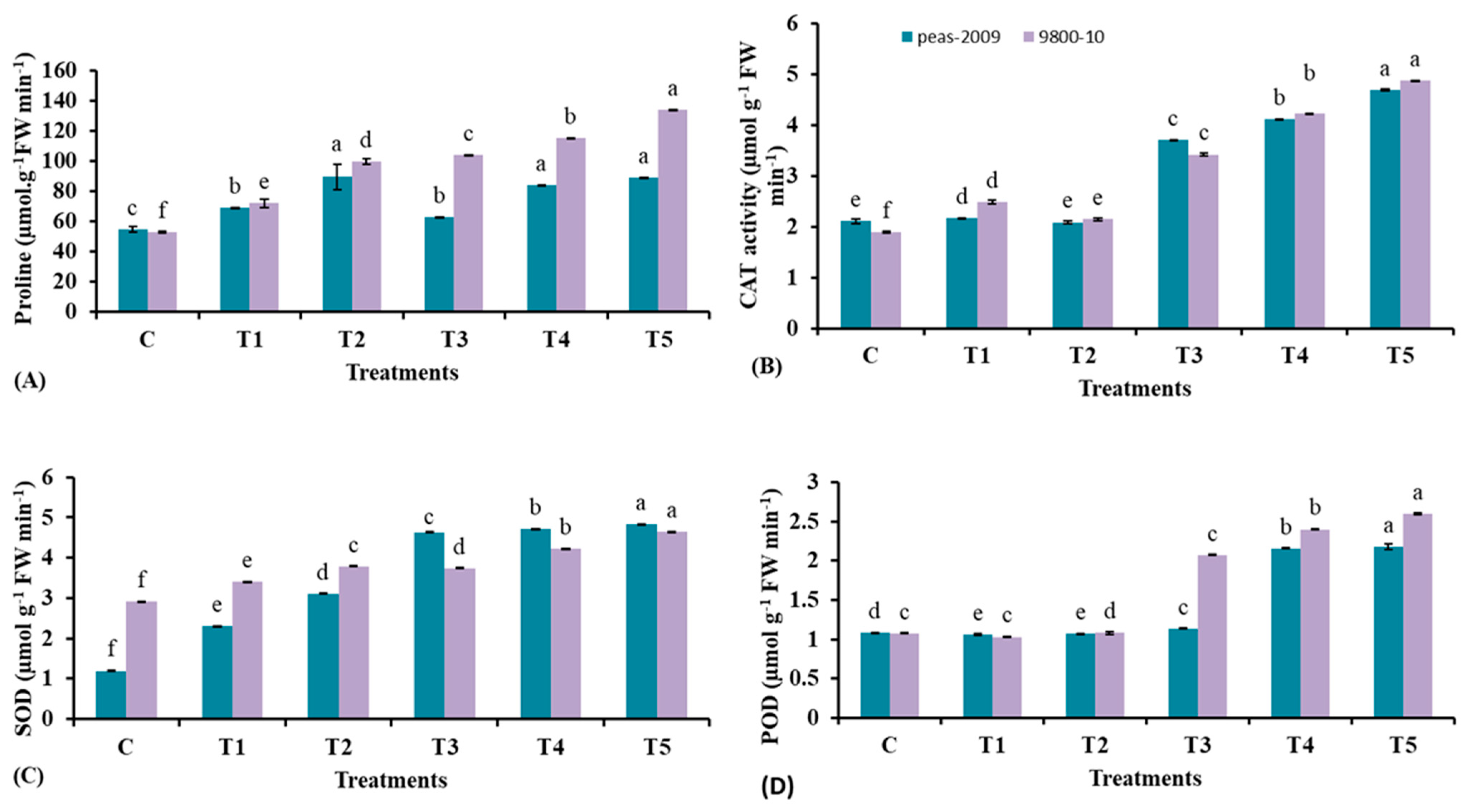
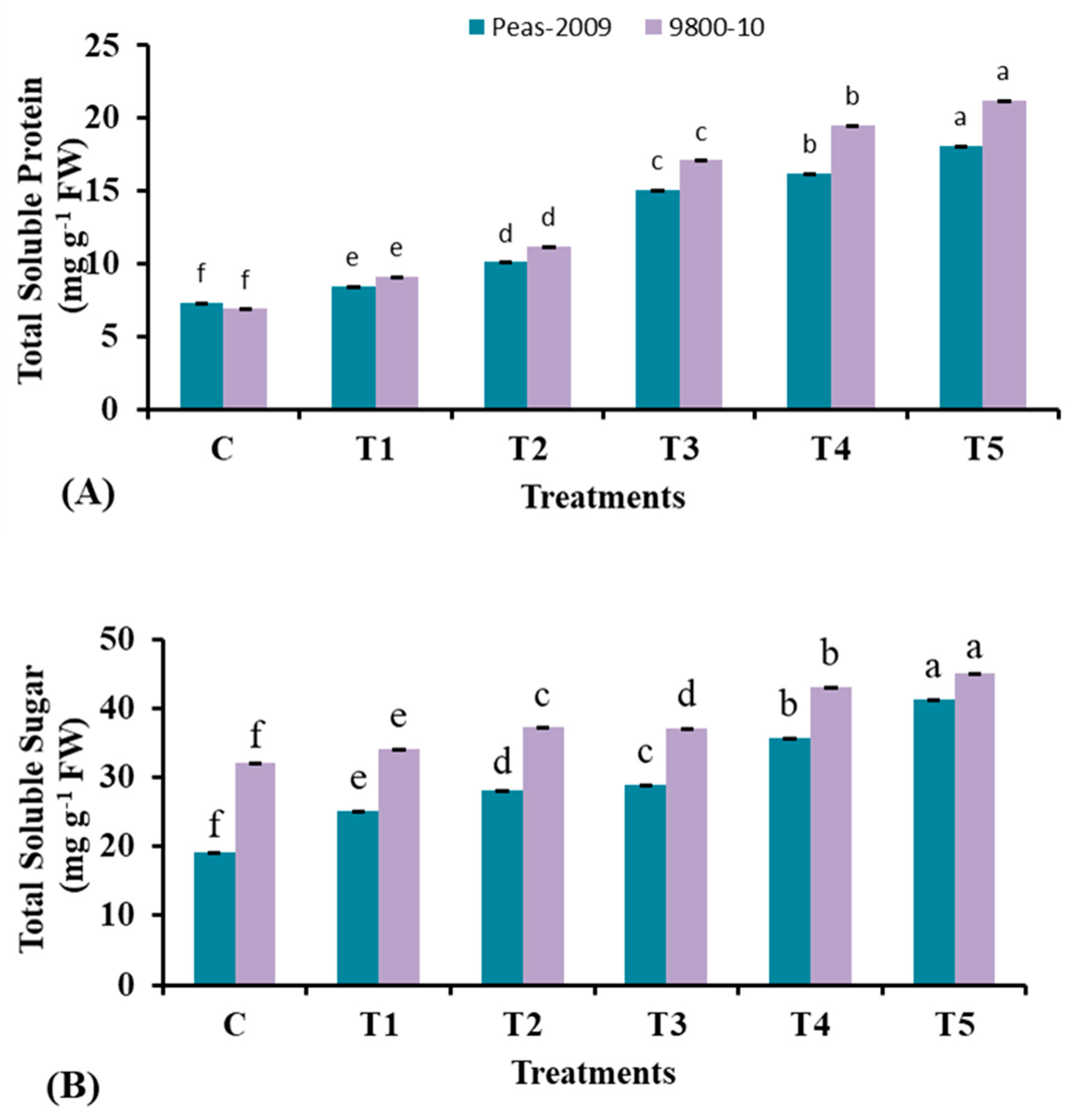
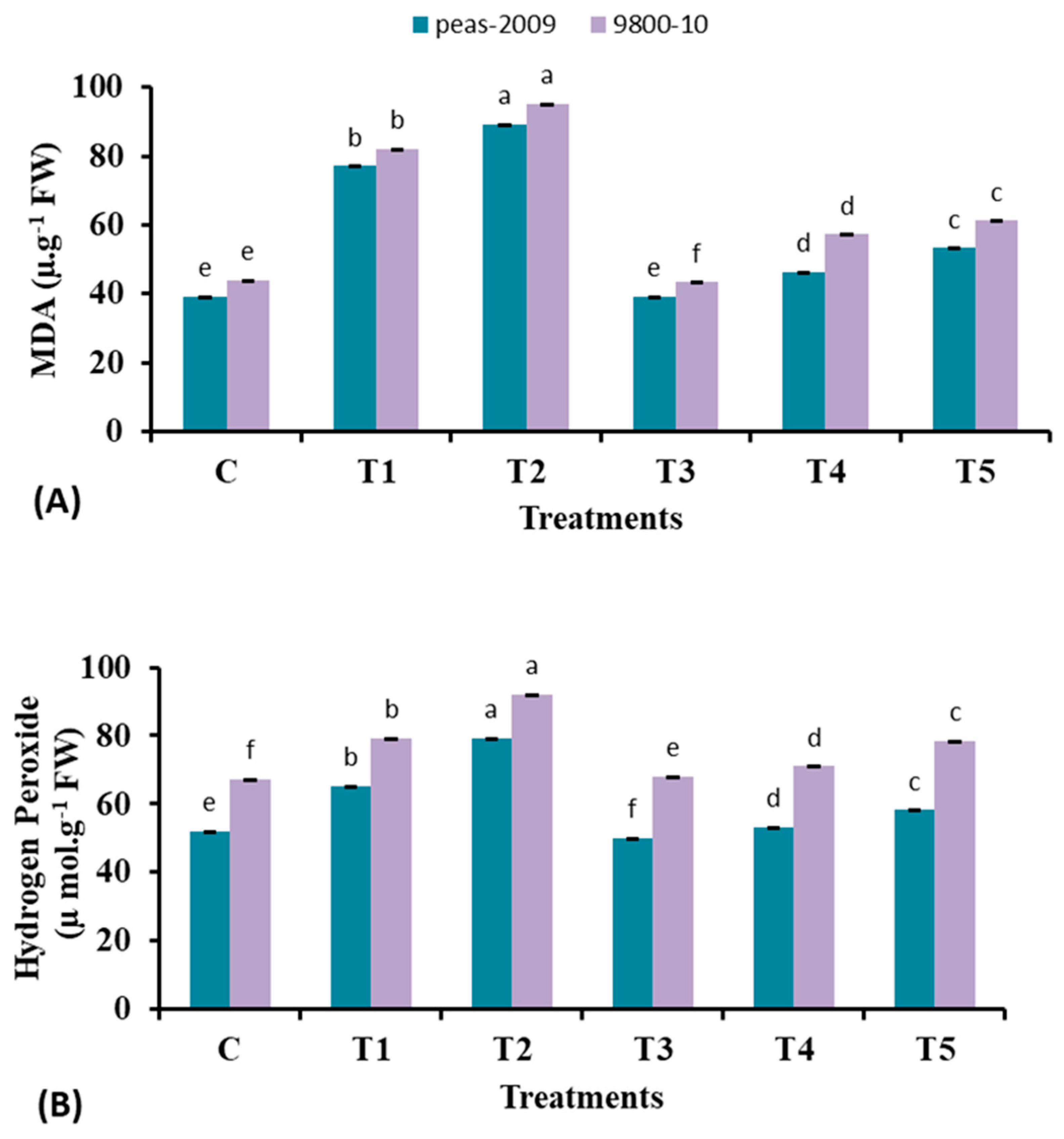
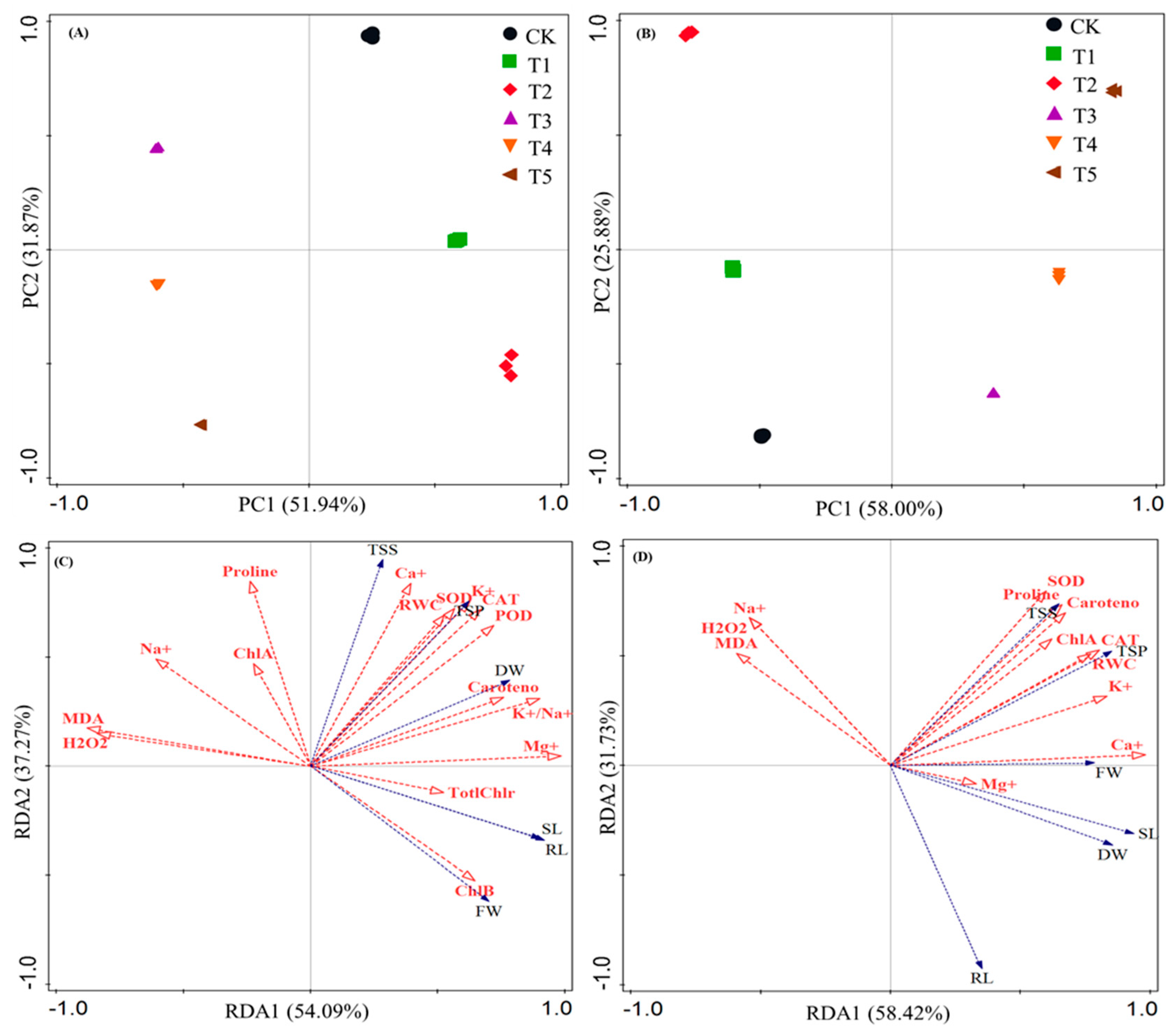
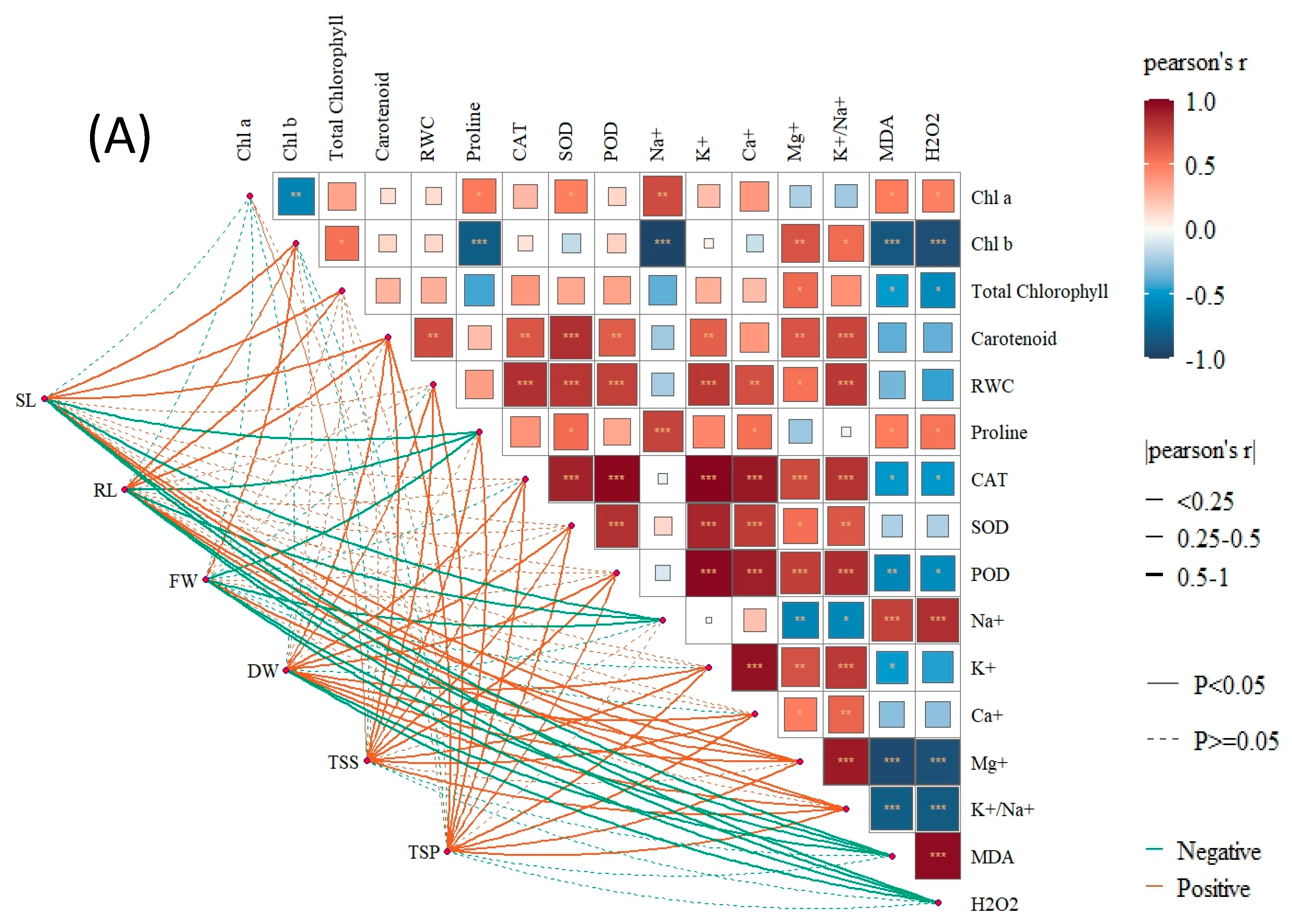
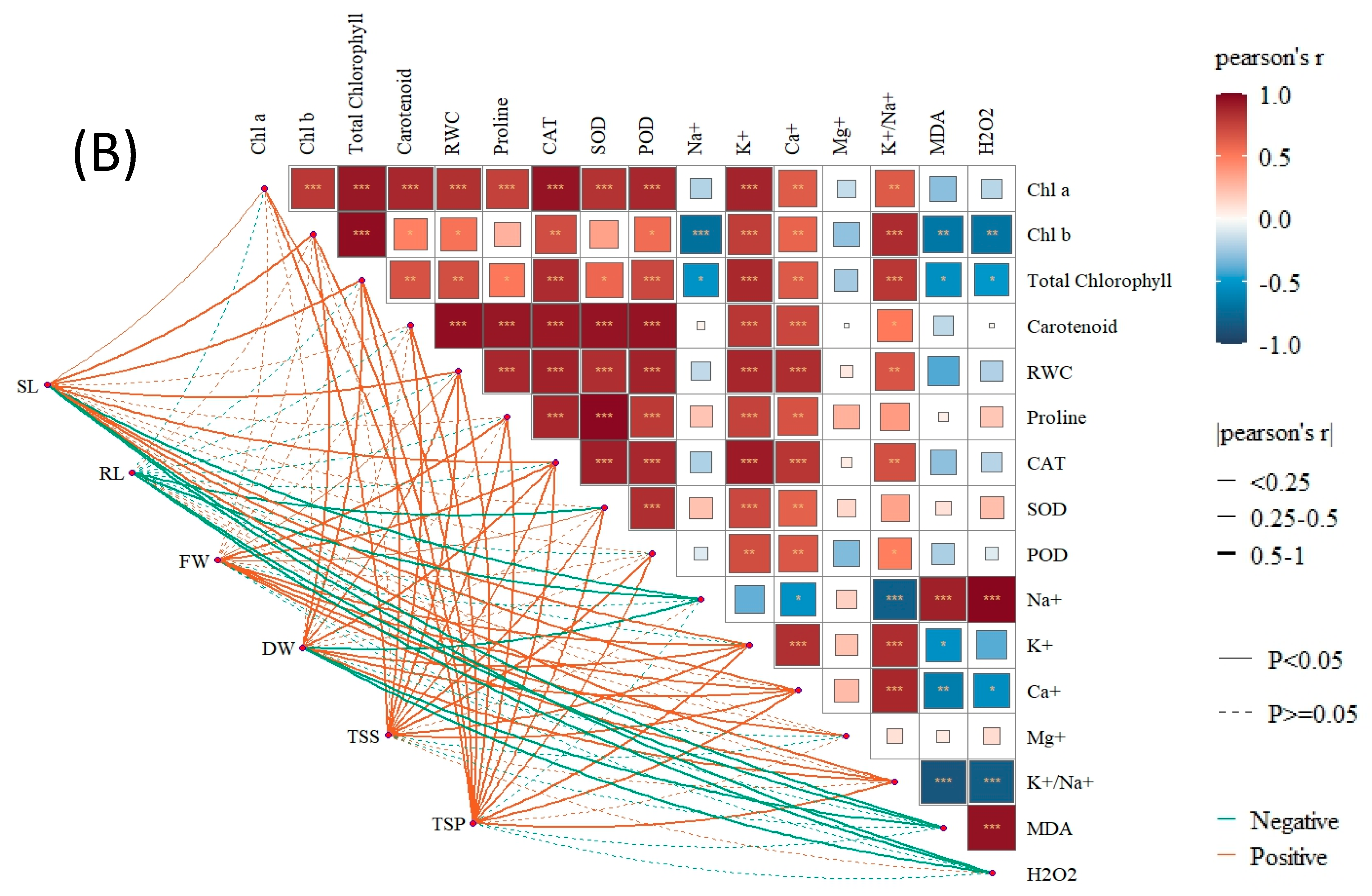
| Na+ (mg·g−1 DW) | K+ (mg·g−1 DW) | Ca+ (mg·g−1 DW) | Mg+ (mg·g−1 DW) | K/Na (mg·g−1 DW) | ||||||
|---|---|---|---|---|---|---|---|---|---|---|
| peas2009 | 9800-10 | peas2009 | 9800-10 | peas2009 | 9800-10 | peas2009 | 9800-10 | peas2009 | 9800-10 | |
| C | 15.85 ± 0.06 f | 16.98 ± 0.03 f | 17.76 ± 0.16 e | 20.69 ± 0.02 e | 18.59 ± 0.09 f | 18.98 ± 0.01 d | 18.47 ± 0.02 d | 28.92 ± 0.01 f | 1.12 ± 0.04 d | 1.21 ± 0.04 c |
| T1 | 18.54 ± 0.01 c | 19.68 ± 0.03 c | 17.18 ± 0.15 f | 20.78 ± 0.08 d | 18.9 ± 0.5 e | 17.32 ± 0.1 f | 10.98 ± 0.12 e | 37.11 ± 0.02 c | 0.92 ± 0.03 e | 1.05 ± 0.04 d |
| T2 | 23.95 ± 0.01 a | 24.3 ± 0.06 a | 17.87 ± 0.13 d | 19.37 ± 0.06 f | 19 ± 0.9 d | 17.85 ± 0.08 b | 10.09 ± 0.16 f | 40 ± 0.02 b | 0.74 ± 0.01 f | 0.79 ± 0.03 e |
| T3 | 16.32 ± 0.02 e | 17.32 ± 0.05 e | 23.45 ± 0.06 c | 25.88 ± 0.03 b | 20.45 ± 0.3 c | 24.96 ± 0.04 b | 24.73 ± 0.3 a | 48.28 ± 0.1 a | 1.43 ± 0.03 b | 1.49 ± 0.03 a |
| T4 | 16.46 ± 0.03 d | 17.45 ± 0.07 d | 26.32 ± 0.04 b | 24.22 ± 0.04 c | 21.67 ± 0.05 b | 25.4 ± 0.1 a | 21.43 ± 0.04 b | 33.15 ± 0.2 e | 1.59 ± 0.1 a | 1.38 ± 0.04 b |
| T5 | 21.99 ± 0.05 b | 20.73 ± 0.04 b | 29.12 ± 0.07 a | 27.96 ± 0.05 a | 24.74 ± 0.2 a | 23.23 ± 0.2 c | 19.73 ± 0.05 c | 34.71 ± 0.3 d | 1.32 ± 0.2 c | 1.38 ± 0.05 b |
Disclaimer/Publisher’s Note: The statements, opinions and data contained in all publications are solely those of the individual author(s) and contributor(s) and not of MDPI and/or the editor(s). MDPI and/or the editor(s) disclaim responsibility for any injury to people or property resulting from any ideas, methods, instructions or products referred to in the content. |
© 2025 by the authors. Licensee MDPI, Basel, Switzerland. This article is an open access article distributed under the terms and conditions of the Creative Commons Attribution (CC BY) license (https://creativecommons.org/licenses/by/4.0/).
Share and Cite
Khan, A.A.; Alabbosh, K.F.; Kashif; Iqbal, B.; Manan, S.; Alhoqail, W.A.; Du, D.-L.; Wang, Y.-F. Ion Homeostasis, Osmotic Adjustment, and ROS Detoxification Underlie Pea Salinity Tolerance Induced by Pseudomonas putida RT12. Microbiol. Res. 2025, 16, 227. https://doi.org/10.3390/microbiolres16110227
Khan AA, Alabbosh KF, Kashif, Iqbal B, Manan S, Alhoqail WA, Du D-L, Wang Y-F. Ion Homeostasis, Osmotic Adjustment, and ROS Detoxification Underlie Pea Salinity Tolerance Induced by Pseudomonas putida RT12. Microbiology Research. 2025; 16(11):227. https://doi.org/10.3390/microbiolres16110227
Chicago/Turabian StyleKhan, Amir Abdullah, Khulood Fahad Alabbosh, Kashif, Babar Iqbal, Sehrish Manan, Wardah A. Alhoqail, Dao-Lin Du, and Yong-Feng Wang. 2025. "Ion Homeostasis, Osmotic Adjustment, and ROS Detoxification Underlie Pea Salinity Tolerance Induced by Pseudomonas putida RT12" Microbiology Research 16, no. 11: 227. https://doi.org/10.3390/microbiolres16110227
APA StyleKhan, A. A., Alabbosh, K. F., Kashif, Iqbal, B., Manan, S., Alhoqail, W. A., Du, D.-L., & Wang, Y.-F. (2025). Ion Homeostasis, Osmotic Adjustment, and ROS Detoxification Underlie Pea Salinity Tolerance Induced by Pseudomonas putida RT12. Microbiology Research, 16(11), 227. https://doi.org/10.3390/microbiolres16110227










